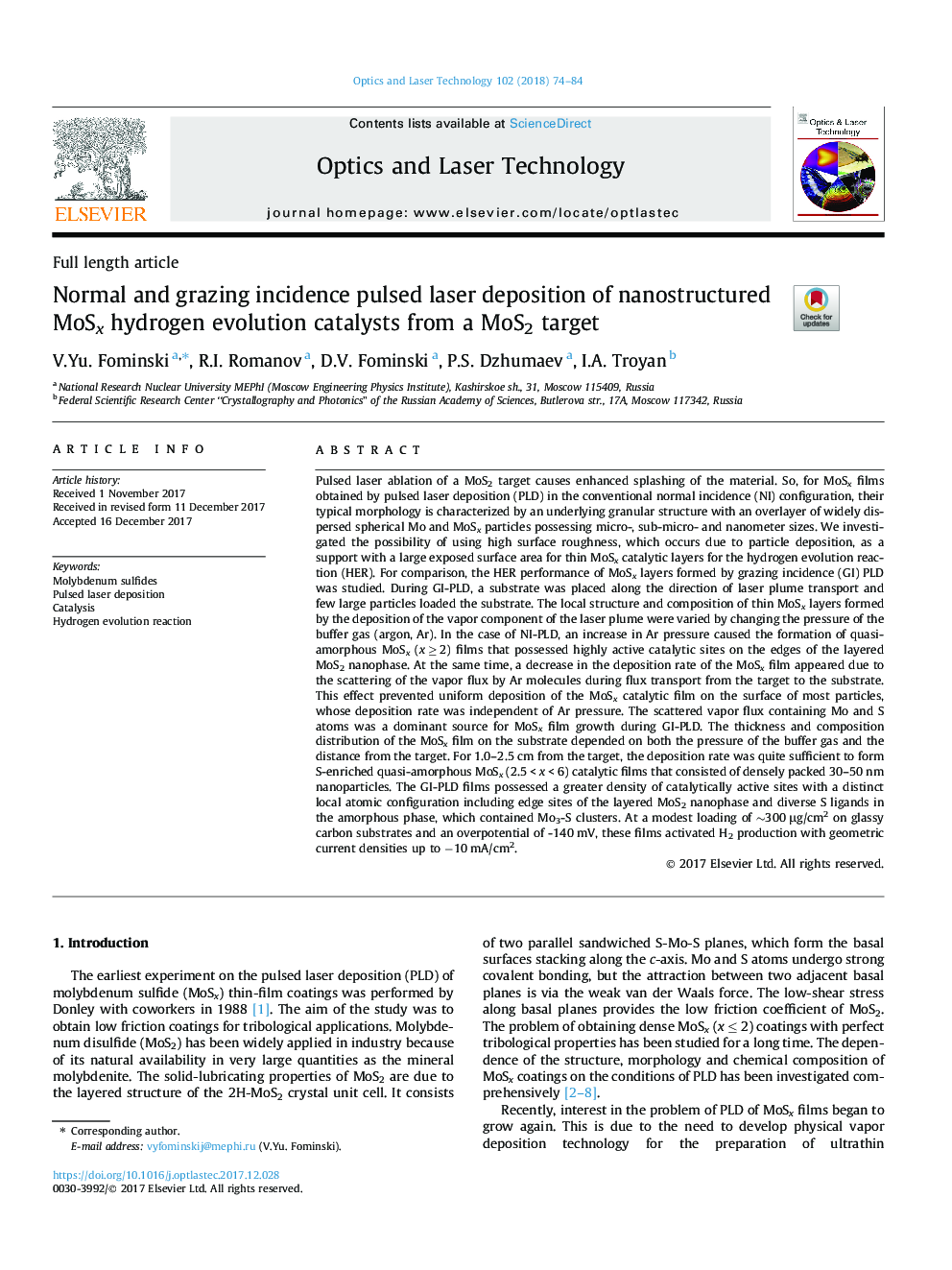| کد مقاله | کد نشریه | سال انتشار | مقاله انگلیسی | نسخه تمام متن |
|---|---|---|---|---|
| 7129034 | 1461597 | 2018 | 11 صفحه PDF | دانلود رایگان |
عنوان انگلیسی مقاله ISI
Normal and grazing incidence pulsed laser deposition of nanostructured MoSx hydrogen evolution catalysts from a MoS2 target
دانلود مقاله + سفارش ترجمه
دانلود مقاله ISI انگلیسی
رایگان برای ایرانیان
کلمات کلیدی
موضوعات مرتبط
مهندسی و علوم پایه
سایر رشته های مهندسی
مهندسی برق و الکترونیک
پیش نمایش صفحه اول مقاله

چکیده انگلیسی
Pulsed laser ablation of a MoS2 target causes enhanced splashing of the material. So, for MoSx films obtained by pulsed laser deposition (PLD) in the conventional normal incidence (NI) configuration, their typical morphology is characterized by an underlying granular structure with an overlayer of widely dispersed spherical Mo and MoSx particles possessing micro-, sub-micro- and nanometer sizes. We investigated the possibility of using high surface roughness, which occurs due to particle deposition, as a support with a large exposed surface area for thin MoSx catalytic layers for the hydrogen evolution reaction (HER). For comparison, the HER performance of MoSx layers formed by grazing incidence (GI) PLD was studied. During GI-PLD, a substrate was placed along the direction of laser plume transport and few large particles loaded the substrate. The local structure and composition of thin MoSx layers formed by the deposition of the vapor component of the laser plume were varied by changing the pressure of the buffer gas (argon, Ar). In the case of NI-PLD, an increase in Ar pressure caused the formation of quasi-amorphous MoSx (xâ¯â¥â¯2) films that possessed highly active catalytic sites on the edges of the layered MoS2 nanophase. At the same time, a decrease in the deposition rate of the MoSx film appeared due to the scattering of the vapor flux by Ar molecules during flux transport from the target to the substrate. This effect prevented uniform deposition of the MoSx catalytic film on the surface of most particles, whose deposition rate was independent of Ar pressure. The scattered vapor flux containing Mo and S atoms was a dominant source for MoSx film growth during GI-PLD. The thickness and composition distribution of the MoSx film on the substrate depended on both the pressure of the buffer gas and the distance from the target. For 1.0-2.5â¯cm from the target, the deposition rate was quite sufficient to form S-enriched quasi-amorphous MoSx (2.5â¯<â¯xâ¯<â¯6) catalytic films that consisted of densely packed 30-50â¯nm nanoparticles. The GI-PLD films possessed a greater density of catalytically active sites with a distinct local atomic configuration including edge sites of the layered MoS2 nanophase and diverse S ligands in the amorphous phase, which contained Mo3-S clusters. At a modest loading of â¼300â¯Î¼g/cm2 on glassy carbon substrates and an overpotential of -140â¯mV, these films activated H2 production with geometric current densities up to â10â¯mA/cm2.
ناشر
Database: Elsevier - ScienceDirect (ساینس دایرکت)
Journal: Optics & Laser Technology - Volume 102, June 2018, Pages 74-84
Journal: Optics & Laser Technology - Volume 102, June 2018, Pages 74-84
نویسندگان
V.Yu. Fominski, R.I. Romanov, D.V. Fominski, P.S. Dzhumaev, I.A. Troyan,